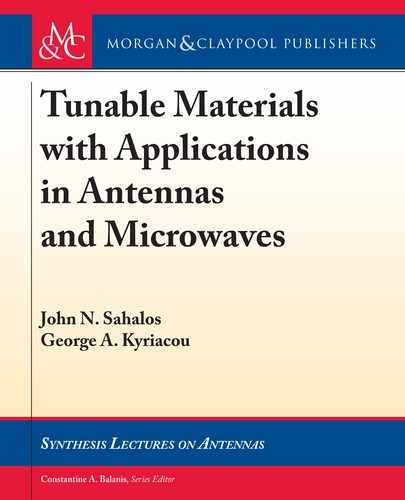1.4. FERRITE–FERROELECTRIC FILMS 7
power (for the DC-magnetic field biasing) and in slow tuning have set back their potentially
widespread application. e above difficulties may be overcome if ferroelectrics are used instead
of ferrites. Of course, we must deal with the very high losses, especially when ferroelectric films
are used. In addition, the required bias voltage is too high (few KV) for bulk ferroelectric ma-
terials [36]. Once again, the multilayer ferrite/ferroelectric structure is expected to be the most
appropriate.
7. Tunable Microwave Resonators
Microwave resonators constitute the basic building block of bandpass and bandstop filters.
Moreover, they are critical components of oscillators and of various sensors and measuring de-
vices. Tunable filters and tunable oscillators are, likewise, based on tunable resonators. us, the
performance of the above filters, oscillators and sensors is primarily dependent on the character-
istics of the resonators involved, like their quality factor, tunability, etc. e electronic tunability
of these resonators is mostly achieved by varying the permeability and/or the permittivity of the
materials comprising the resonator structure. For cavity resonators, this is the material con-
tained in the cavity. For printed resonators, the tunable material is either its substrate or its
superstrate or an inclusion within each of them. Futhermore, the tunable material losses (loss
tangent) strongly affect the resonator quality factor, which, in turn, affects the performance of
the constructed microwave device.
Until recently, a major problem concerning the miniaturization of microwave devices is
the inability to integrate resonators and, in turn, filters within a monolithic circuit. is is simply
due to the basic physical property that microwave resonators have dimensions of at least a quarter
(
g
=4), and usually a half (
g
=2), of the guided wavelength. e use of materials such as ferrites
and ferroelectrics, with their high relative permeability and permittivity (
r
and "
r
1), serve
the miniaturization task since
g
is inversely proportional to the square root of (
r
"
r
). Moreover,
the development of resonators printed on ferrite or ferroelectric multilayer film structures enables
the integration of resonators into microwave integrated circuits (MIC) as well as monolithic ones
(MMICs). Once again, the most promising structure is that of multilayer ferrite/ferroelectric
films [15, 37] and [38].
1.4 FERRITE–FERROELECTRIC FILMS
e most serious problem in ferroelectrics and especially those of the thin film form is their high
RF losses (high tan ı). Ferroelectrics, however, have a strong advantage in tunability, which
is achieved by the control of permittivity through a biasing DC-electric field and, in turn, a
corresponding DC voltage. On the other hand, the main disadvantage of ferrites is the need for
electromagnets that provide the variable DC bias magnetic field. Even though ferrites usually
have lower RF losses than ferroelectrics, the electromagnets are usually heavy devices with high
DC controlling power consumption. is is also true for the advanced implemented “miniature
electromagnets” [12].
..................Content has been hidden....................
You can't read the all page of ebook, please click here login for view all page.
